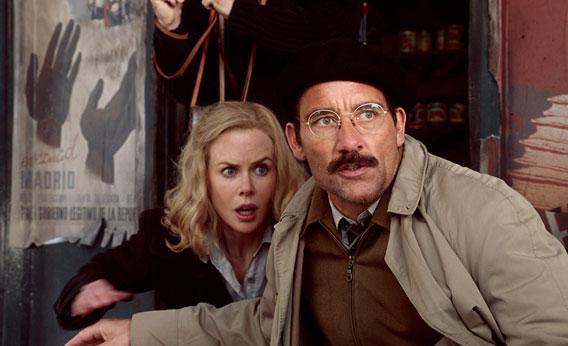HBO will commemorate Memorial Day by paying tribute to Martha Gellhorn (1908-1998), the pioneering war correspondent who filed vivid dispatches from Normandy and Saigon and an underappreciated fiction writer who composed a perfect short story titled “Miami–New York,” about an in-flight fling between an officer and a lady. Such is the territory worked by Hemingway & Gellhorn (Monday at 9 p.m. ET)—war and romance. In the emotional equivalent of combat scenes, director Philip Kaufman, working from a script by Jerry Stahl and Barbara Turner, recreates the battles Gellhorn waged as the third of Ernest Hemingway’s four wives.
And the romance? Well, Hemingway & Gellhorn’s daft romanticization of its subjects proves central to its overwrought sense of self. This is the kind of film where the protagonists consummate their affair while Fascists are shelling their hotel. The transition from fear to desire is plausible enough, proceeding from a moment where the man presses the woman into a wall in a frantic attempt to protect her. But soon they are coolly trading caresses on a mattress, bodies erotically dolloped with flakes of ceiling plaster.
How do you like Clive Owen, gentlemen, as the smug face and slapping voice of midperiod Papa? We first see Hemingway in Key West, Fla. in 1936, gurgling rum and ginning up machismo on his boat, surrounded by an entourage that seems to swell and grow more fetid each time the story returns to Florida, with the blue-collar courtiers decomposing into a chorus of flunkies and enablers. He is reeling in a marlin. The scene is unreeling is scratchy black-and-white until the fish bleeds ruby red across the deck—a foretaste of the cinematographic kitsch that contributes to movie’s uniquely fascinating badness.
The fishing trip complete, Papa repairs to Sloppy Joe’s for alcohol and self-adulation. In his ragged clothes and sweaty skin, he looks like something best used to wipe a dipstick, but that is all a part of being the most celebrated author in America, so there’s a glow about him. In walks this long healthy Bryn Mawr girl, here on a family vacation. She is played by Nicole Kidman, and so she gets the married author’s attention. She banters with the insouciance of Lauren Bacall in To Have and Have Not, and so she sustains it. She reveals herself as the author of a social-realist novella titled The Trouble I’ve Seen and produces from her pocketbook a review favorably comparing her talents to his, thus conjuring the spirit of competition that sparks their love and ultimately torches it.
Soon we are in Spain, where Hemingway is working with the novelist John Dos Passos (David Strathairn) and the film director Joris Ivens (Metallica’s Lars Ulrich) to create a propaganda film urging support of the anti-Franco forces in the Spanish Civil War. Gellhorn arrives to cover the fight for Collier’s. Hemingway & Gellhorn is framed by (and punctuated with) scenes of an elderly Gellhorn addressing a documentary crew. Kidman gives a spot-on performance as that hard-living woman journalist of a certain age: Her affect brushes brusquely past no-nonsense to arrive at stern-but-sensual. She puts on a tough front that extends all the way to the back of her clear, deep, arrogant eyes that have seen more than you would care to. But the woman who shows up in Spain is simply a plucky kid modeling a J. Peterman pea coat. Witnessing the steady transformation of the tyro into the veteran—watching her learn something from her husband’s pugilistic attitude and then watching her struggle to evade the emotional punches—is the film’s chief pleasure.
Its chief pain, meanwhile, concerns a lot of monkeying with the visual texture of things. Hemingway & Gellhorn constantly slips from color to black-and-white to sepia tones and skips among illusions of various film stocks. There has been an attempt to match the actors’ scenes with file footage of loyalists on the march in Madrid and pedestrians out for a stroll in Manhattan, and you may be offended, late in a movie so generally trifling, to see that Gellhorn’s visit to Dachau includes film of the prisoners’ corpses. The actors, via special effects, frequently walk through repurposed newsreels like so many Zeligs and Gumps. The technique proves most memorably risible when combined with recontextualized quotes—when, for instance, Hemingway, admiring a soldier, turns to Gellhorn and says, “Look at that fucking grace under pressure.” When Hemingway is in conversation with someone who has been on the cover of Time, it is extremely likely that said cover will appear in the scene, and when he settles in to binge on Hemingway daiquiris, he recites the recipe very clearly. It is certain that the filmmakers have done their homework and no less certain that they’ve constructed an awkward digital diorama.
“The most essential gift for a good writer,” Hemingway once said, “is a built-in, shock-proof, bullshit detector.” While you watch this curio of literary mythmaking, yours will be buzzing away.
